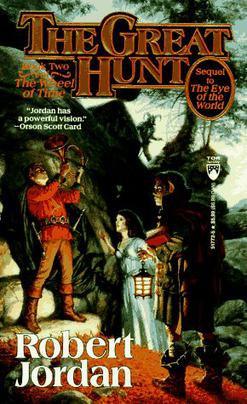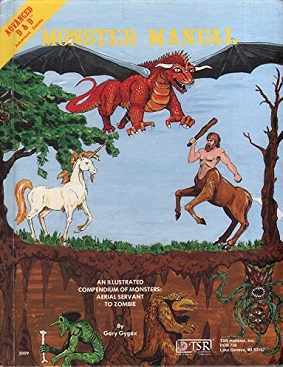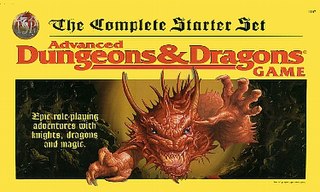This article needs additional citations for verification .(August 2014) |
The Wheel of Time Roleplaying Game is a role-playing game based on The Wheel of Time , an epic fantasy series by American author Robert Jordan.
This article needs additional citations for verification .(August 2014) |
The Wheel of Time Roleplaying Game is a role-playing game based on The Wheel of Time , an epic fantasy series by American author Robert Jordan.
The team at Last Unicorn Games created the licensed role-playing game The Wheel of Time Roleplaying Game which was published in 2001 by Wizards of the Coast after they purchased Last Unicorn. [1] : 317 The game was published in November 2001. [2]
The game consists of two publications by Wizards of the Coast, a core rulebook published in October 2001 and an expansion, The Prophecies of the Dragon, which followed in April 2002. Shortly after the release of Prophecies of the Dragon, Wizards of the Coast confirmed that they would not be proceeding with any further expansions for the game. The roleplaying game rights have since reverted to the estate of Robert Jordan.
The core rulebook is a 317-page large-format hardcover book. It was written and compiled by Charles Ryan, Steven Long, Christian Moore and Owen K.C. Stephens for Wizards of the Coast. Robert Jordan served as a creative consultant and contributed an introduction, in which he revealed that he used to serve as Dungeon Master in Dungeons & Dragons games played by his stepson Will and his friends. The book has a cover by Darrell K. Sweet, who also provides the covers for the novels, and maps by Ellisa Mitchell, who likewise provides cartography for the novels. A large number of artists provide full-color art throughout the book.
The rulebook is based on the D20 rules system used by the third edition of Dungeons & Dragons, also published by Wizards of the Coast, and follows a similar layout and format to the D&D core rulebooks. However, the term 'Dungeon Master' is not used (as this is reserved for D&D products only), being replaced by the more generic 'gamemaster' to refer to the player running the game.
The game does not use different races, as in the novels there are only two sentient, naturally-evolved species, namely humans and Ogier (optional rules for playing an Ogier are provided). Instead, different backgrounds are provided which serve a similar function. These are Aiel, Atha'an Miere (Sea Folk), Borderlander, Cairhienin, Domani, Ebou Dari, Illianer, Midlander (principally a native of Andor but also Far Madding, Ghealdan, Murandy, Amadicia and northern Altara ), Tar Valoner, Taraboner and Tairen.
The standard D&D character classes have been replaced by new ones: algai'd'siswai (Aiel spear-carrier), Armsman (soldier), Initiate (in the Aes Sedai or other-culture counterparts, or Asha'man), Noble, Wanderer, Wilder (untrained user of the One Power) or Woodsman (similar to a D&D Ranger). It is also possible to multiclass (having different levels in different classes).
The Wheel of Time Roleplaying Game also shares D&D 3rd Edition's use of prestige classes, which add additional abilities to the existing classes. The prestige classes used in the Wheel of Time Roleplaying Game are: Aes Sedai, Asha'man, Blademaster, Commander (military officer), Gleeman, Thief-Taker, Warder, Windfinder, Wise One and Wolfbrother.
The use of Feats and Skills is similar to D&D 3rd Edition. However, specialist feats allowing the use of the One Power also exist. There are also special 'Lost Ability' Feats that can be used to replicate abilities in the books, such as talking to wolves (like Perrin Aybara and Elyas Machera), viewing the future (like Min Farshaw), dreamwalking, foretelling, and the ability to 'sniff' out violence (as Hurin, in The Great Hunt).
There is a chapter discussing equipment and weaponry, a further chapter discussing how to run and play Wheel of Time Roleplaying Game adventures, and notes on using characters from the series as non-player characters. There is also an extensive chapter discussing rules for the use of the One Power (including how to handle male channellers and the threat of madness).
There is a lengthy section about the setting and history of The Wheel of Time, much of which comes from the novels and The World of Robert Jordan's The Wheel of Time . However, there is information included which is unique to this product, including the exact circumstances under which countries such as the Borderlands, Cairhien, Illian, Tarabon, and Tear were founded during the War of the Hundred Years.
The book features re-drawn, full-color, and larger-scaled maps of the cities of Ebou Dar, Caemlyn, Cairhien, and Tar Valon. Maps of these cities previously appeared in the novels. The maps of Tanchico and Far Madding from the books are not reprinted. Of greater interest are the never-before-seen maps of the capital cities of Tear and Illian. There is also another map of the main continent, similar to the one found in the hardcovers of the later novels.
There is an adventure called 'What Follows in Shadow', set during the events of The Eye of the World , which features the adventuring party running afoul of Padan Fain during the procession of Logain Ablar through the city. The adventure ends with the adventurers lost in the Ways, ready for the events of The Prophecies of the Dragon adventure book.
A web enhancement for the game was released on the Wizards of the Coast website at the same time the book was published. This short downloadable file contained a few new Feats and channeling abilities, information on new NPCs, and background information on the countries of Ghealdan, Mayene, and Murandy (including new information on their histories not found elsewhere). This web enhancement is no longer available through the Wizards of the Coast website.
Dragon Annual #6 2001, included new content for the RPG. Two articles were presented in the magazine, content included beasts of the wheel of time and new hero templates for quick character creation.
Prophecies of the Dragon is the only expansion to The Wheel of Time Roleplaying Game that was published. It is a 191-page large-format softcover book. It was written by Aaron Acevedo, Evan Jamieson, Michelle Lyons, James Maliszewski, Charles Ryan and Paul Sudlow for Wizards of the Coast. Again, cartography was handled by Ellisa Mitchell, and a new cover was produced by Darrell K. Sweet. Robert Jordan is listed as a creative consultant.
The concept behind the book is to provide a massive roleplaying campaign that runs alongside the storyline of the first six Wheel of Time novels. The campaign is broken into a series of five major episodes with a number of smaller 'mini-adventures' leading into the campaign or to serve as diversions between the main adventures. Robert Jordan has ruled the new information revealed in the book about certain characters (namely Mazrim Taim) non-canonical.
The mini-adventures are designed to get the players from wherever they ended up at the end of the 'What Follows in Shadow' adventure in the RPG core rulebook to where the longer campaign begins, on Toman Head, or to serve as interludes in the main campaign. The first mini-adventure, 'Howls in the Night', sees the players investigating a series of wolf attacks on a remote village. 'Escort Duty' has them escorting a wealthy merchant to the Murandian capital of Lugard. In 'Hunters for the Horn' reports emerge that the Horn of Valere can be found in the Hills of Kintara and the PCs are drawn into the search for the artifact. 'The Watchtower' sees the PCs taking on a Draghkar which has set up a lair in a watchtower overlooking the road from Tarabon to Arad Doman. 'My Secret Friend', set after the Seanchan invasion, has the PCs investigating the disappearance of a young boy who is trying to nurse a lopar back to health, and getting involved with Shadowspawn sent to spy on the Seanchan advance. 'I Want to Stay Single' has the PCs hired by the son of the mayor of Ostin Falls, a town on the border between Toman Head and Almoth Plain, who is evading an arranged marriage by investigating reports of fighting on Toman Head. This adventure can also act as a springboard into the main campaign.
The main campaign consists of five sequential, serialized adventures.
The campaign concludes at this point. Given that the players will have likely reached the attention of Rand himself by the end of the campaign, it falls to the gamemaster to decide what adventures follow through the remainder of the novels.
Prophecies of the Dragon features a number of new maps, including the towns of Aturo's Orchard and Tobin's Hollow on Toman Head (all created for this book), plus the city of Falme and a general map of the western coast of the continent, stretching from Tanchico to Bandar Eban. The town of Denhuir in Saldaea is also shown. The map of the Two Rivers from The Eye of the World is reprinted in full color as well. Finally, there are maps showing the Battle of Emond's Field from The Shadow Rising and the Battle of Dumai's Wells from Lord of Chaos.

Dungeons & Dragons is a fantasy tabletop role-playing game (RPG) originally created and designed by Gary Gygax and Dave Arneson. The game was first published in 1974 by Tactical Studies Rules, Inc. (TSR). It has been published by Wizards of the Coast, now a subsidiary of Hasbro, since 1997. The game was derived from miniature wargames, with a variation of the 1971 game Chainmail serving as the initial rule system. D&D's publication is commonly recognized as the beginning of modern role-playing games and the role-playing game industry, and also deeply influenced video games, especially the role-playing video game genre.

The Wheel of Time is a series of high fantasy novels by American author Robert Jordan, with Brandon Sanderson as a co-author for the final three novels. Originally planned as a six-book series at its debut in 1990, The Wheel of Time came to span 14 volumes, in addition to a prequel novel and three companion books. Jordan died in 2007 while working on what was planned to be the twelfth and final volume in the series. He prepared extensive notes, which enabled fellow fantasy author Sanderson to complete the final book, which grew into three volumes: The Gathering Storm (2009), Towers of Midnight (2010), and A Memory of Light (2013).

The Great Hunt is a fantasy novel by American author Robert Jordan, the second book of The Wheel of Time series. It was published by Tor Books and released on November 15, 1990. The Great Hunt consists of a prologue and 50 chapters. In 2004 The Great Hunt was re-released as two separate books, The Hunt Begins and New Threads in the Pattern.
Forgotten Realms is a campaign setting for the Dungeons & Dragons (D&D) fantasy role-playing game. Commonly referred to by players and game designers alike as "The Realms", it was created by game designer Ed Greenwood around 1967 as a setting for his childhood stories. Several years later, Greenwood brought the setting to publication for the D&D game as a series of magazine articles, and the first Realms game products were released in 1987. Role-playing game products have been produced for the setting ever since, as have various licensed products including novels, role-playing video game adaptations, comic books, and the film Dungeons & Dragons: Honor Among Thieves.

The Monster Manual is the primary bestiary sourcebook for monsters in the Dungeons & Dragons fantasy role-playing game, first published in 1977 by TSR. The Monster Manual was the first hardcover D&D book and includes monsters derived from mythology and folklore, as well as creatures created specifically for D&D. Creature descriptions include game-specific statistics, a brief description of its habits and habitats, and typically an image of the creature. Along with the Player's Handbook and Dungeon Master's Guide, the Monster Manual is one of the three "core rulebooks" in most editions of the D&D game. As such, new editions of the Monster Manual have been released for each edition of D&D. Due to the level of detail and illustration included in the 1977 release, the book was cited as a pivotal example of a new style of wargame books. Future editions would draw on various sources and act as a compendium of published monsters.

Lord of Chaos is a fantasy novel by American author Robert Jordan, the sixth book of his series The Wheel of Time. It was published by Tor Books and released on October 15, 1994, and was nominated for the Locus Award for Best Fantasy Novel in 1995. Lord of Chaos consists of a prologue, 55 chapters, and an epilogue. It is the first book of the Wheel of Time to have an epilogue.

Dungeonland (EX1) is a 1983 adventure module for the Dungeons & Dragons (D&D) roleplaying game, written by Gary Gygax for use with the First Edition Advanced Dungeons & Dragons (AD&D) rules. It is an adaptation of Lewis Carroll's 1865 novel Alice's Adventures in Wonderland, with the various characters from the book translated into AD&D terms.

Ravenloft is an adventure module for the Dungeons & Dragons (D&D) fantasy role-playing game. The American game publishing company TSR, Inc. released it as a standalone adventure booklet in 1983 for use with the first edition Advanced Dungeons & Dragons game. It was written by Tracy and Laura Hickman, and includes art by Clyde Caldwell with maps by David Sutherland III. The plot of Ravenloft focuses on the villain Strahd von Zarovich, a vampire who pines for his lost love. Various story elements, including Strahd's motivation and the locations of magical weapons, are randomly determined by drawing cards. The player characters attempt to defeat Strahd and, if successful, the adventure ends.
Richard Baker is an American author and game designer who has worked on many Dungeons & Dragons campaign settings.

Knife of Dreams is a fantasy novel by American author Robert Jordan, the eleventh book in his series The Wheel of Time. It was the last book which Jordan wrote completely before his death in 2007, with Brandon Sanderson finishing the series afterwards based on Jordan's notes. It was published by Tor Books in the U.S. and Orbit in the UK and released on October 11, 2005. Upon its release, it immediately rose to the #1 position on the New York Times hardcover fiction bestseller list, making it the fourth consecutive Wheel of Time book to reach the #1 position on that list. Knife of Dreams is 784-pages long, including a glossary. It has a prologue, 37 chapters, and an epilogue.

D&D Adventurers League, or simply Adventurers League for short, is the organized play association for the Dungeons & Dragons (D&D) roleplaying game which is officially administered by D&D's publisher, Wizards of the Coast. Prior to 2014, it was known as the Role Playing Game Association Network. The organization was originally established by D&D's previous publisher, TSR, Inc., in 1980.
Several different editions of the Dungeons & Dragons (D&D) fantasy role-playing game have been produced since 1974. The current publisher of D&D, Wizards of the Coast, produces new materials only for the most current edition of the game. However, many D&D fans continue to play older versions of the game and some third-party companies continue to publish materials compatible with these older editions.

James Wyatt is a game designer and a former United Methodist minister. He works for Wizards of the Coast, where he has designed supplements and adventures for the Dungeons & Dragons (D&D) roleplaying game. He is the author of sci-fi and fantasy novels, including Forgotten Realms books, and the 4th edition Dungeon Master's Guide.
The flexibility of the Dungeons & Dragons (D&D) game rules means that Dungeon Masters (DM) are free to create their own fantasy campaign settings. For those who wanted a pre-packaged setting in which to play, TSR, Wizards of the Coast (WotC), and other publishers have created many settings in which D&D games can be based; of these, the Forgotten Realms, an epic fantasy world, has been one of the most successful and critically acclaimed settings. Many campaign settings include standard sword and sorcery environments, while others borrow Asian, Central American, swashbuckling, horror and even space-travel themes.

The Pathfinder Roleplaying Game is a fantasy role-playing game (RPG) that was published in 2009 by Paizo Publishing. The first edition extends and modifies the System Reference Document (SRD) based on the revised 3rd edition Dungeons & Dragons (D&D) published by Wizards of the Coast under the Open Game License (OGL) and is intended to be backward-compatible with that edition.

The Dungeons & Dragons Starter Set is a category of companion accessories across multiple editions of the Dungeons & Dragons fantasy role-playing game. In general, the Starter Set is a boxed set that includes a set of instructions for basic play, a low level adventure module, pre-generated characters, and other tools to help new players get started.